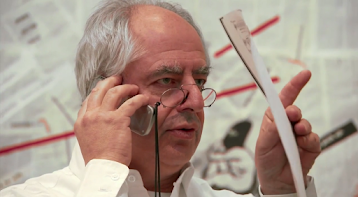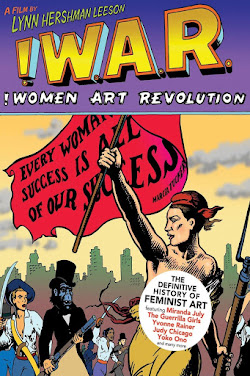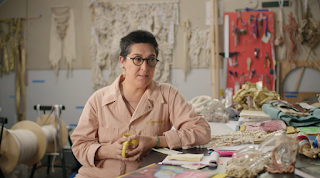Art21: "Compassion" (S5, E1)
In this episode of Art21, the focus is on the theme of "compassion" through the works associated with artists William Kentridge, Carrie Mae Weems, and Doris Salcedo.

William Kentridge Talking on the Phone. 2009. "Compassion," Art21
William Kentridge is a South African artist, known for his drawings, performances, and especially his animation films. His focus is to convey the political events of South Africa into poetic stories. This is evident through his Drawings for Projection film series which highlights the southern area of Johannesburg city, to which factories and industrialization creates a bleak and grim environment. These films utilize his charcoal drawings, each meant to contain a single frame and photographed with 16 or 33 mm film. History of the Main Complaint (which Art21 shows a snippet of) is the sixth film of the series. The film is about Soho Eckstein who is in a hospital bed surrounded by surgeons, attached to many support machines, conveying how dangerously ill he is. The rest of the film serves to showcase the events that unfolded that transpired to leave Soho at this point. I found the animation fascinating to watch, as knowing that all the frames are individual charcoal drawings adds to the films tone and subject matter. The drawing look beautifully haunting, as Kentridge doesn't shy away from utilizing rich darks to the softest whites. The animation feels simple, but the transitions between actions feels very authentic and flow easily, especially when Kentridge does this through simply using his eraser, adding to a "rawness" that is present in the film's overall style. He mentions that "one does think with one's hands," and that he admires "the fidgeting of charcoal, scissors, or tearing of something in my hands, as if there's a different brain that is controlling how that works," conveying the idea of how both parts of his mind are at play when he works.
Drawing from History of the Main Complaint (1996). Animated film using charcoal and pastel drawings. 35mm film transferred to video. 5 min 50 sec.

Carrie Mae Weems Excited about her Portraits. 2009. "Compassion," Art21
Carrie Mae Weems was born in Portland, Oregon, and is considered one of the most important and influential contemporary artists. She is regarded for her photography and videos that are meant to dive into societal and oral history. She also means to explore the relationship of her family in her work, to which she said "It was important for me because I really needed to understand something about the nature of my own being and my own voice and really where I come from." According to her life story, her grandfather (because he was Native American, and "passed off as white") tried to employ his entire family in Portland, Oregon. However, because the majority of her family at the time were African American, he and her family still faced prominent racism. Her fascination with photography came from her boyfriend when she moved to San Francisco and ultimately decided against going into dance and theatre and instead focusing on art. One series of hers that Art21 focuses upon is the series she undergoes with her students to which they re-create the "idea" of 1968, with the events that took place in mind. As such, they recreated moments of the Birmingham riots to the traumas of losing those like Martin Luther Kind and Malcom X. One work that I included below is The First Major Blow which highlights the JFK assassination. Each re-creation takes place in the same setting, and is meant to be a "construction" of history (hence the use of the podium and lights). As such, each work is meant to be seen and interpreted as not only a re-creation but almost like a "performance" of what happened, allowing the viewer to consider deeply how things have changed over the years, and yet how we have progressed despite what has happened.

The First Major Blow (2008). Archival pigment print. 61 × 51 inches. Jack Shainman Gallery, New York.

Doris Salcedo Helping her Friend. 2009. "Compassion," Art21
Doris Salcedo is a Colombian artist and sculptor, sometimes combining furniture pieces into one, even if it's impossible. Her works are inspired by her life in Colombia, and are meant to convey the marginalized within the Third World, connecting to not just victims but also the culprits. She admits that her work "is based not on my experience but on somebody else's experience," to which their experience is "literally defined." Coming from Colombia, she said that the land is "nothing but ruins!" because of the aftermath of wars, colonialism and imperialism. Her work also isn't meant to represent something, but rather "hint" at it that is "no longer here." Sometimes her works come from whatever information is given to her, or through the information she finds out herself (nothing she makes are "fictitiously" created). Her most interesting work (which Art21 also highlights) is her Noviembre 6 y 7 piece. The work was meant to commemorate the anniversary of the seizing of the Supreme Court, to which many people were killed over the course of 53 hours. She wanted to "follow the tempo" of the seizure, in which she assembled chairs flowing down in all kinds of directions on the Palace's walls. She started this at 11:35 AM sharp, because it was then that the first person was killed. The piece lasted 53 hours (just like the length of the actual event) as a means to reenacting what occurred in order to keep it from being forgotten.

Noviembre 6 y 7 (2000) Installation at Palace of Justice, Bogotá, Colombia. Alexander and Bonin Gallery, New York
Overall, I thought all of these artists emphasized the theme of "compassion" wonderfully. I feel that they all meant to emphasize the idea to their audience, as a means of connecting the viewer to the subjects the artist's chose. Kentridge wanted his viewers to understand the political strife happening in South Africa and the traumas of the individuals that lived there. Carrie Mae Weems wanted her viewers to understand their past history and find a means of recognizing and gathering together to help one another, which I find beautiful and heartwarming. Doris Salcedo wanted her viewers to understand the crises of Colombia, her home, emphasizing how the Palace of Justice siege was one of the most deadliest attacks in the country. Many of these works evoke a beautiful message of learning to understand one another, even when it may be done sometimes through hauntingly dark visuals.
Information Sources:
https://art21.org/artist/william-kentridge/
https://www.art.co.za/williamkentridge/history-of-main-complaint.php
https://www.tate.org.uk/art/artworks/kentridge-history-of-the-main-complaint-t07480
https://art21.org/artist/carrie-mae-weems/
https://art21.org/artist/doris-salcedo/
https://whitecube.com/artists/artist/doris_salcedo
* This episode was 54 minutes and 9 seconds long.*



Very good, well-written summaries of the segments. I'd love to read your reflections on the whole episode. Why did Art21 choose these artists to feature in "Compassion"? Would Kentridge and Salcedo agree with Weems that their art about something bigger than themselves? Do you admire that value for artists?
ReplyDelete